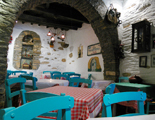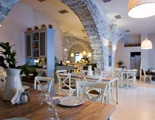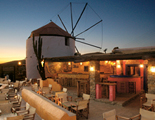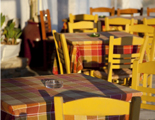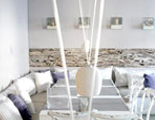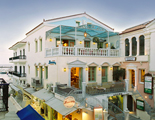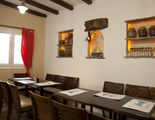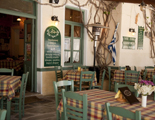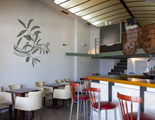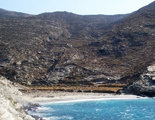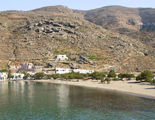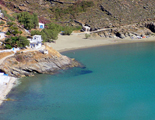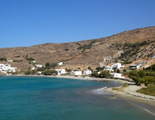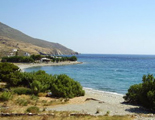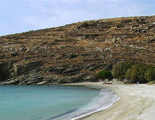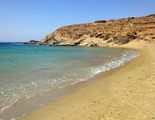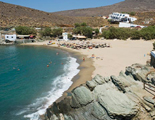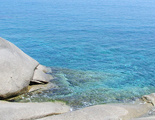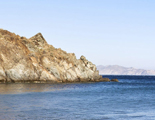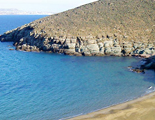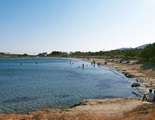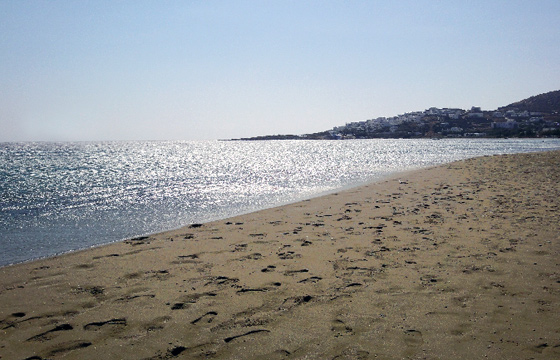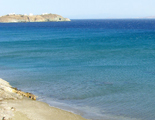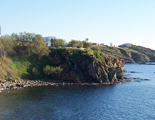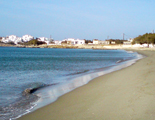 Tinos Travel Guide
Tinos Travel Guide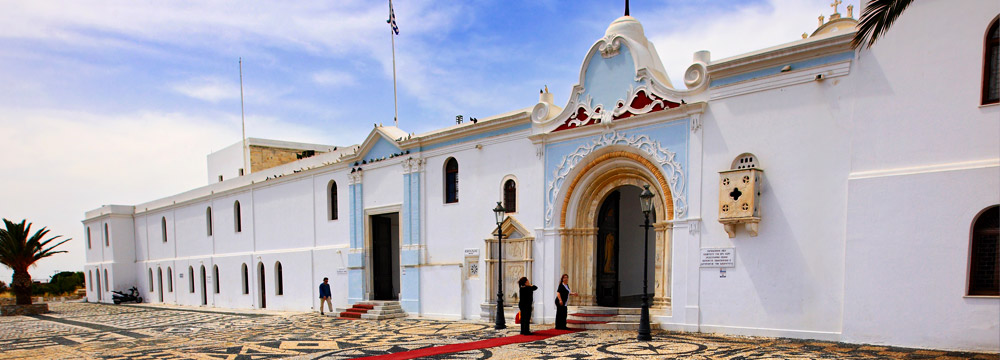
Tinos owes its name to its first inhabitant “Tinos”. Tinos was the leader of an Ionian team that came to the island from Asia Minor. However, some say that “Tinos” came from the word of the Phoenicians “Tenok” which means snake. In the past, it was also called “Ophiousa” (“ophis” means snake in Greek), because of the large number of snakes on the island, and also “Hydrousa” because of the plethora of running waters.
Although it is widely believed that the island’s first inhabitants were Ionians in the 12th century B.C., there are signs of inhabitance in the 3rd millennium B.C. by Karians too. Prehistoric findings include shells located in the Vryokastro region.
Ionians came to Tinos around 1130 B.C. and the ancient years were a period of prosperity, with impressive works being constructed. The most astonishing of them is the aqueduct of Peisistratus, which was finalized in 542 B.C. and was the main water supply system of Hora until 1934 A.C. Furthermore, Tinos assisted Athens in the Persian wars and the trireme of Panaitios joined the Greek naval force right before the Salamina naval battle, which led to Tinos name being written on the respective tripod at Delphi. Tinos was consecutively dominated by the Macedonians, the Ptolemaists and, at the end of the ancient era, by the Romans. Two ancient Greek authors have written about Tinos: Aristotle wrote “The State of the Tinians” and Ainissidimos “Tiniaka”; but both works have been lost.
Tinos was very often attacked by Saracens, Arabs, Goths and Ottomans during the Byzantine years, which led to the island’s decline. The situation further deteriorated due to earthquakes and plagues, the worst of which lasted 52 years and diminished the island’s population to a great extent. During this period, many inhabitants left the island seeking for better life conditions.
The year 1204 was among the most important years in the history of the island, since it was bought by two brothers, Andrew and Jeremiah Ghisi, who were aristocrats from Venice. Tinos was governed by Venetians until 1715 and the large number of Catholics on the island goes back to that period. Venetians protected Tinos by organizing the fortress of Exomvourgo (or Xombourgo) that used to be the island’s capital at the time.
Tinos is probably the only region in Greece that had such a brief period of Ottoman domination in the 18th century. In 1715, Janoum Hodge came with more than 25,000 men and 45 ships, and occupied the island. This generated astonishment in Venice, since Tinos was known as a very powerful region with excellent defense, which was considered impenetrable. So, the island’s governor was accused of bribery and was condemned to death (he was poisoned). The Turkish dominance ended in 1770, and during that period the island’s capital was transferred to Hora.
Despite the fact that the Russians dominated Tinos for only 4-5 years, they restructured the island’s defense and renovated the Kechrovounio monastery and built the Saint Catherine’s Church, while they destroyed many Catholic churches and monasteries.
Tinos was the first Cycladic Island to participate in the Greek revolution on March 31, 1821, and, more specifically, the revolution initiated at the village of Pyrgos. The most important historic event of Tinos in the recent years is the miraculous finding, in 1823, of the Orthodox image of Virgin Mary after the vision of nun Pelagia concerning its position. The image finding was followed by the construction, from 1823 to 1831, of the Church devoted to Virgin Mary. This Church of unique architecture is a meeting point for Christians from all over the world, with many miracles being recorded and many precious items being gifted to the Church as a token of gratitude to Virgin Mary. The years that followed the completion of the Church were years of culture and artistic expression, with Tinos being the home town of many Greek artists.
On August 15, 1940, the Italian fleet torpedoed the Greek ship “Elli” in the port of Tinos, on the day of the local festival and religious celebration. The foundation of the Church donated, then, all its precious items to the Greek state for the provision of guns and supplies to the Greek army during the Albanian war.
Today, Tinos is one of the most important islands in Greece, attracting a large number of tourists, not only because of its grandiose church, but also thanks to its diverse landscapes, wonderful beaches, historic monuments and natural beauty. The island remains among the regions in Greece that are considered centers of culture, with sculpture and painting being developed and used even as part of the architecture.
Among the numerous Tinian artists are included world renowned painters like Nikolaos Gizis, Nikiforos Lytras, Nikolaos Gaitis (also a sculptor) and Frangiskos Dessypris, and famous sculptors like Giannoulis Halepas, Demetrios Filippotis, Lazaros Lameras and the Vitalis brothers.
According to the myth, Hercules chased and killed the sons of Vorias (the word for northern wind in Greek) or Aeolus, the ancient god of the winds, because they abandoned the Argonauts when the ship Argo passed by Tinos. So, Hercules found them on the island’s highest mountain “Tsiknias” or “Gypas”, killed them both and buried them on the top of the mountain. When their father found out that his sons were buried at Tinos, he was furious and decided to “punish” the island by blowing very strong northern winds, which is the first thing that visitors notice when arriving at Tinos.
According to another myth, the cave located at the point where the mountain Tsiknias meets the sea in the area of Faneromeni is interconnected with the top of the mountain. This is the spot that Aeolus chose to blow, through this tunnel, creating huge waves to the sea.
The ancient god Poseidon, worshiped as the god of the sea and as a great doctor, is known to have exempted the island from snakes and reptiles by sending a swarm of storks to exterminate them. Ever since, Poseidon became the protector of Tinos and a glorious temple, the largest and most famous in the ancient years, dedicated to him was built at Kionia. Only some ruins of the temple are preserved nowadays.
The Church of Virgin Mary or Evangelistria Church at Hora is the most famous and among the most grandiose churches in Greece. It was built between 1823 and 1831 on the spot where was found the Orthodox Image of Virgin Mary, after a vision of nun Pelagia (who later was acknowledged as a Saint). The spacious temple is of traditional architecture with many arches and consists of a two-floor building and many smaller buildings in its courtyard, which houses artistic objects, ecclesiastic items and other precious historic objects.
The Evangelistria Church is known as one of the most miraculous in Greece, since many people with serious illnesses have been cured after praying to Virgin Mary in this Church. This is why, many Christians from different parts of the world return to the Church every year to thank Virgin Mary, offer precious items made of silver and gold to the Church and most of them arrive from the port to the Church on their knees, as a token of gratitude. This is a unique image and revives at large on August 15th, which is a glorious day of celebration for the whole island.
Visitors, apart from kneeling and feeling the amazing energy of the temple, have the opportunity to admire works of art of renowned painters and sculptors, as well as objects that were important for the Greek history in the venues around the courtyard of the Church.
The Monastery of the Lady of the Angels at Kechrovouni was built after three sisters had the same vision: a woman, Virgin Mary, indicated them to build a monastery at a specific point at Kechrovouni, where there was a strange light. Because very strong winds were blowing at this specific location, which was also “inhabited” by many snakes, they decided to build the monastery on a different position, slightly to the south. However, the cells that were initiated during the day were mysteriously demolished during the night and every morning the tools were found at the spot that was initially indicated in the vision. This happened several times, until finally everyone was convinced that the monastery had to be built at the initial spot.
The monastery was built in the 11th or 12th century A.C. and is a perfect sample of the Cycladian architecture, has a wonderful view (due to its 600 m. of altitude), houses a significant library with more than 2,000 titles and offers the possibility to visit the cell of Saint Pelagia, which remains just the same as it was when it was inhabited by Her.
The Abbey of the Sacred Heart of Jesus was first founded in the 17th century, but in a different location. It was destroyed by the Turks and at the end of the 19th century, Catholic monks renovated the almost totally destroyed church of Saint Sophia at Exomvourgo and renamed it Church of the Sacred Heart of Jesus. Today, it is a beautiful white Catholic abbey where visitors can also eat and stay over. In the middle of the courtyard there is the statue of Sacred Heart of Jesus, created by Filippotis in 1950. The abbey organizes its annual feast with various events on the second Sunday of July.
It is located right in the heart of Hora and hosts important findings including large storage jars of the 8th century B.C., statues and architectural parts of the ancient temple of Poseidon at Kionia, currencies and more. The entrance to this museum is of symbolic character, and thus a visit to the museum is affordable by everyone.
The Museum of Tinian Artists is housed at the courtyard of the Virgin Mary Church. Visitors can admire the works of various Tinian artists, like paintings of N. Ghisis, Nikif. Lytras, G. Roilos, G. Renieris, G. Gaitis, and sculptures of G. Halepas, L. Sohos, D. Filippotis, G. Vitalis, I. Voulgaris and others.
At the courtyard of the same Church is also found The Antonios Sohos Museum, where visitors can see wooden and plaster sculptures used for decorative purposes of this unique artist that also was an academic.
The museum has been inaugurated in the year 2007 at the village of Pyrgos and is the most modern architectural building of the island. The Museum presents the circle of the marble, i.e. the various stages between the excavation of marbles until the creation of sculptures. Audiovisual presentations are combined with sculptures exhibitions providing a complete sense of the entire process.
Before leaving Pyrgos there are two other museums worthy of a visit: The House-Museum of Giannoulis Halepas, hosting personal items, family pictures, sketches, and sculptures of the great artist, and the Museum of Panormos’ Artists, where sculptures of G. Halepas, D. Filippotis, E. Lambaditis, I. Voulgaris, L. Doukas, I. Vitalos and L. Sohos (the father of Antonis Sohos mentioned above)are presented. All these artists were born in Tinos and lived in the wider area of Panormos.
The Museum of Isternia’s Artists obviously houses works of art of artists that came from the village of Isternia, where it is located, including: L. and M. Fytalis (the Fytalis brothers), J. and F. Malakates (the Malakates brothers), G. Vitalis, L. and A. Sohos, and L. Lameras.
The Art Gallery is accommodated at an internal part of the courtyard at the Virgin Mary Church and gives visitors the possibility to admire more than 100 paintings of famous painters, both from Tino and from other regions of Greece, like Nik. Lytras, G. Iakovides,N. Gizis, K. parthenis, I. Altamouras, K. Volonakis, and G. Roilos, but also renaissance paintings from Italy, and decorative objects from all over Europe.
At another part of the Virgin Mary Church courtyard is housed the Exhibition of Ecclesiastic Heirlooms and Images which hosts Orthodox images created between the 14th and 19th century, the Chart of Rigas Ferraios (one of the three Charts that have “survived”), the ring of Kolokotronis, and paintings and sculptures of various artists.
The Arnados’ Ecclesiastical and Rural Museums are two little museums located at Arnados village, hosting ecclesiastical items and books, and rural objects respectively.
The Museum of Folk Art at Steni is a rather young museum, founded in the year 2000. It hosts important objects of the everyday life of the last two centuries.
Finally, the Cultural Foundation of Tinos is a center of research, art exhibitions and an ideal conference venue. It hosts various events, an annual festival in the summer and is housed at a building of unique traditional architecture.
Tinos is famous for its wonderful villages that amaze visitors with their architecture, their morphology and their natural beauty.
Volax is definitely the most bizarre setting in Tinos, famous all over the world. Huge spherical stones and granite rocks of volcanic origin surround the village, made of traditional white houses with colorful gardens. There is also an outdoor theatre made of stone and Volax is the place where basketry is still among the main occupations of the population.
Kardiani is a special village situated on the mountain Pateles, in northwestern Tinos. It is a village with running waters, plethora of fountains (even in the houses) surrounded by trees, and is based on the Cycladic architecture, with white houses bearing arches. The village’s charming landscape is completed with its narrow streets and paths, while at the same time it has a splendid view and beautiful beaches nearby.
Isternia is like a balcony to the Aegean Sea. Built on the mountain Meroviglia, it has a marvelous view to Syros and it is among the largest villages of the Island. The beauty of Isternia is due to the fact that artists, who were born and lived in the village, have created many sculptures and works of art, which are visible everywhere: on the houses doors and courtyards, on the churches, on stairs, belfries or even on the floors. Isternia is like an open-air exhibition accessible free of charge all year long.
Pyrgos is the largest village in Tinos and one of the oldest ones, owing its name to a castle (called pyrgos in Greek) mentioned in files of the 16th century A.C. Pyrgos is the birthplace of many renowned artists like Halepas, Filippotis, Lytras and others. The whole village is dispersed with works of arts and sculptures decorate everything, just like at Isternia.
However, if Isternia can be characterized as an open-air exhibition, Pyrgos can be characterized as an open-air museum due to its size. At Pyrgos there is the Museum of Marble Art and the unique School of Fine Arts, where studies last for 3 years and involve courses on marble sculpture on, architecture, sculpture on other materials or painting, History of Art, and essay writing. This School has actually been a place where young artists, between 15 and 28 years old emerge. Last but not least, Pyrgos is a very well developed village offering many accommodation choices to the visitors.
Panormos is the port of Pyrgos, located on the northern part of the Island. Built on a natural bay this village is surrounded by splendid beaches while its Cycladic architecture with minimal white houses attracts many visitors. Panormos also has many taverns offering fresh fish, seafood and Mediterranean recipes, and it is also quite lively with many youngsters preferring its cosmopolitan beaches.
Arnados is situated on the eastern part of the Island and it is the village of the highest altitude. It has a unique view to Mykonos and has a special atmosphere due to its medieval galleries and its paths paved with slabs. Taverns and cafeterias welcome the guests to Arnados, while there are also two museums: the Ecclesiastical Museum and the Rural Museum.
At Kionia was probably located the most glorious temple of the Ancient Times, devoted to god Poseidon and his wife Amphitriti. This grandiose temple was of Dorian architecture and was created by famous sculptures like Telesinos from Athens and Agasias from Ephesus. It is remarkable that Andronikos from Kyristos, Macedonia, constructed an amazing solar clock, which is now exhibited at the Archaeological Museum of the Island. Moreover, the temple had elements of Tinian architecture based on local marble and gneiss, like for example a fountain. Some parts of the temple have survived and Kionia is a site not to be missed.
Exomvourgo lies at an altitude of 640 m. in the center of the Island. This rock was inhabited during the Bronze Age. Findings at Exomvourgo include a cemetery of the Geometrical Period, the Temple of the Big Goddess and Daughter of the same period (10th -7th century before B.C.), later devoted to Goddess Demetra and her daughter Persephone, and the fortress built in the 13th century A.C., which is in a quite good condition today. At Exomvourgo the old chapels of Saint Minas and saint Eleousa built in 1828, and the aforementioned Monastery of the Sacred Heart of Jesus are also located.
Location: Tinos Hora
CLIMATE
The climate in Tinos is Mediterranean, which means that the winters are not very rough and the summers are hot with plenty of sunshine. The average temperature during springtime is 15.9°C, during summertime 25°C, during fall 19.43°C and during wintertime 10.87°C. During the hottest months of the year, i.e. from May to October, the strong northern winds make the heat less intense. Tinos has more than 3,000 hours of sunshine per year. However, due to the winds, the sea transportation from and to the island is not possible for a few days every year.
TELEPHONE
The national prefix for Greece is +30 if you are calling from abroad. All numbers in the capital Athens start with the prefix 210 and are followed by 8 digits (e.g. 210-3227400).
The Area Code for Tinos is: +30 22830. If you wish to call abroad, you have to start by dialing the other country’s national prefix (i.e. 0049 for Germany, 0044 for England etc.) and continue with the area code and the number where you wish to call.
CURRENCY
Euro €
Euro Coins: 1 and 2 euro coins (gold and silver color), 10, 20 and 50 cents (gold color) 1, 2 and 5 cents (copper color)
1 euro = 100 cents / centimes.
Euro Bank Notes: Are available in 5, 10, 20, 50, 100, 200 and 500. It is not always easy to receive change for 200 and 500 Euro Notes.
BY AIR
Tinos does not have an airport. The closest airports are located at the islands of Syros and Mykonos, with which Tinos is connected by boat on a daily basis.
BY BOAT
Tinos is connected by boat with the ports of Piraeus and Rafina, both ports easily accessible by travelers arriving from abroad to the Eleftherios Venizelos airport. It is also connected directly to the islands of Andros, Syros and Mykonos, and to almost all Cycladic islands with stops in-between. The trip lasts from 1 hour and 45 minutes (with a high-speed from Rafina) to 4 hours and 40 minutes (with a regular boat from Piraeus).
For information on ports and schedules, please visit the following websites:
- ANEK LINES www.anek.gr
- BLUE STAR FERRIES www.bluestarferries.gr
- NEL LINES www.nellines.gr
- SEA JETS www.seajets.gr
LOCAL BUSES
Local buses connect Hora to the most popular villages and beaches, including Kionia, Isternia, Kardiani, Pyrgos, Panormos, and Agios Ioannis Porto. For more information please call: +30 22830 22440
TAXI SERVICE
Taxis are available at Hora. Tel.: +30 22830 22470
BOAT
Daily excursions are organized to the island of Delos (less than 2 hours away) and to secluded beaches. These excursions are organized by local travel agencies.
BANKS & ATMS
The following banks have branches and ATMs in Hora:
ALPHA BANK: Eleftherias Square 4, Hora, Tel.: +30 2283023601
ATE BANK: Eleftherias Square, Hora, Tel.: +30 2283022666
EFG EUROBANK ERGASIAS: N. Louvari Street, Plaka, Hora, Tel.: +30 2283024766
EMPORIKI BANK: Trion Ierarchon 6 Street, Hora, Tel.: +30 2283022232
NATIONAL BANK OF GREECE: Pandanassas Square, Hora, Tel.: +30 2283023088
PIRAEUS BANK: Akti Vasileos Konstantinou & Paraliaki Odos, Hora, Tel.: +30 2283029210
MONEY EXCHANGE
Money can be exchanged in the bank branches listed above.
POST OFFICE
The Greek post office is called ELTA and you can find the main post offices of the island in Hora where there is also a branch of the Hellenic Post Bank. Post Boxes in Greece are YELLOW for normal post, usually with 2 slots for INTERNAL POST (meaning inside Greece) and post for ABROAD. RED Post Boxes are rarer and they are used for URGENT mail. You shouldn’t expect to find such boxes in the island. REGISTERED mail is always handled and given a receipt for at the POST OFFICE.
Post Office in Tinos Tel. no: +30 2283022247
POLICE STATION
Tel.: +30 22830 22210, +30 22830 23781
MUNICIPALITY OF TINOS
Tel.: +30 22830 23733, +30 22830 22237
- Radio Taxi: +30 22830 22470
- Tourist Police: +30 22830 23670
- Port Authority: +30 2283022348
- Hellenic National Meteorological service: +30 2109699101-3
- Elpa (Car breakdown tourist information service): 174
INTERNATIONAL PRESS
No international press can be found on the island, so please make sure to buy anything you need in advance from Athens or Piraeus.
EMERGENCY NUMBERS
- Police: 100
- Fire Department: 199
- Ambulance: 166
HEALTH
- Health Center: +30 2283023784
- Medical Center of Isternia: +30 2283031206
- Medical Center of Steni: +30 2283041229
- Medical Center of Komi: +30 2283051210
PHARMACY
The following pharmacies are located in Hora:
Apergis Emmanuel, 2 Trion Ierarchon Street, Tel.: 2283022213
Hadjiloui Frangiska, 7 Alavanou Z. Ave., Tel.: 2283023888
Krikeli Evdokia, Pandanassas Square, Tel.: 2283022272
Mali or Malli is a tranquil, white pebbles beach on the northern part of the island, facing the southern part of the island of Andros. This beach was recently discovered thanks to the new road constructed at Northern Tinos, and attracted swimmers that appreciate pebbles, tranquility and picturesqueness right away. Very few white houses surround the beach, all of traditional Cycladic architecture, completing the image of a tranquil paradise.
Rohari is the largest and most popular beach at the Panormos area, hosting a beach bar that provides; from umbrellas and showers to refreshments, coffee and snacks. The spacious sandy beach is a top destination for youngsters. Rohari is only 1 km. away from the picturesque fish village of Panormos, which used to be the port of Tinos and is definitely worth a visit.
Right underneath the unique village Isternia, the homonym cove offers two beaches, one with sand and the other with pebbles, but both with transparent waters and marvelous sunset views. The cove's calm waters is an excellent choice when there are strong northern winds, whereas the long path connecting the beach with the village of Isternia is suitable for trekking lovers.
Either way, a visit to the village is just mandatory! On the beach, there are also two taverns and a cafeteria.
Ormos Giannaki is a beach with sand and pebbles, two taverns and umbrellas, but there is also natural shade provided by tamarisk trees. The beach is connected with the village of Kardiani with a traditional old path, a path worth climbing since it boasts a marvelous view to the island of Syros. Kalivia is a small, tranquil bay at the eastern part of the beach which is a great choice for families.
Lichnaftia is an isolated, not organized beach, at the eastern part of the island. The waters are blue and crystal clear, but what really makes it unique is the black and white pebbles spread all around on the golden sand. At Lichnaftia, the blue horizon seems infinite, whereas it is the right place for a romantic couples’ getaway with its marvelous scenery in a full moon night.
Agios Petros is a tranquil beach with white sand close to the village of Kardiani. The water is crystal clear and the picturesque catholic chapel, built in the 16th century, lies on the rock above the beach.
The beach is really windy, especially in August, and visitors should make provisions for food, water and umbrellas. However, Agios Petros is just ideal for a picnic, since its tranquility and wonderful view capture visitors to remain on the beach for hours.
Agios Romanos is a big and tranquil beach with sand and little pebbles, providing shadow with its tamarisk trees and a wonderful view to the island of Syros. Access to this beach is quite easy through the new road leading from Hora to Kionia.
There is a tavern, which is among the beat taverns on the island, so visitors don’t have to worry about food. Going down an old path on the west you will meet the little isolated beach Apigania.
Two separate beaches form the beach known as Kolimbithra. The smaller one is fully organized and has a cosmopolitan flair, while the larger one is more tranquil. The view to the little island “Drakonisi” is splendid and there are also taverns on the small beach, where umbrellas, toilets, showers, beach volley and water sports are also available. There is a small lake with ducks and turtles nearby and Kolimbithra is a biotope of rare birds.
Livada is definitely the most impressive beach of Tinos. It has pebbles and crystal blue deep waters, surrounded by strange big rocks with numerous holes of various sizes. The road to the beach is not so good, and passenger cars may have a problem accessing it.
The area next to the beach is ideal for exploration, with oak trees, a lake with ducks and a small river reaching the sea, explaining why the water at Livada is so cold.
Santa Margarita is an isolated sandy beach, about 4 km. from the island's largest village Steni. The beach, owing its name to the homonym catholic chapel on its left side, is totally secluded and visitors have to bring with them necessary supplies like water and snacks.
Santa Margarita, apart from its turquoise waters, boasts an unusual morphology since a big rock stands at one side and multiple smaller rocks are spread at the other side with golden sand lying in between.
Pachia Ammos is a large, isolated beach at about 10 km from Hora. Visitors prefer this beach for its wild beauty and its uniquely colored, thick, green sand, which creates the illusion of grass when viewing the beach from a distance.
Moreover, Pachia Ammos hosts a dune, similar to the dunes in a desert. There are neither umbrellas nor a beach bar, so visitors must be prepared and carry anything necessary (water, snacks, umbrellas, etc.).
Agios Ioannis Porto is one of the two most popular beaches on the island. The fact that this a large sandy beach with clean shallow waters is not affected by northern winds, makes it highly recommended for families with young children and also explains why this used to be Tinos’ port. Moreover, visitors have the ability to buy snacks, water and refreshments at the beach bar and choose between umbrellas and tamarisk trees for shade.
Laouti or Skylantari is the continuation of the Agios Sostis sandy beach and has transparent waters and a sandy sea bed. There is the possibility for water sports and the beach is also equipped with umbrellas, taverns, cafeterias and a mini market, whereas tamarisk trees provide natural dew and shade. The orientation of Laouti does not protect it from the wind and there are usually high waves in August.
Agios Sostis is a sandy beach with calm, clean and shallow waters, absolutely safe for families with children. On the rock above the beach lies the homonym little church, built in the 19th century.
There are also taverns, a beach bar and a sea wall for diving. This beach has a magnificent view to the island of Mykonos, specifically in the period of etesian winds that make the atmosphere transparent.
Kionia is a large pebble beach close to the island's capital offering various services to its guests, like umbrellas, sea bikes and Jet Ski rentals. The beach lays in front of the ruins of the ancient temple of Poseidon, the God of the Sea, and attracts many tourists. In addition Kionia settlement is among the most popular destinations on Tinos, hosting many hotels, taverns, and bars.
Stavros is a combination of sandy and pebbled coast next to Hora, right before Agios Markos. Images of Stavros bear an uncanny resemblance to paintings, with green cliffs all around it, crystal blue waters and the little church of "Stavros" completing the landscape.
Most visitors choose Stavros for afternoon swimming, because the view during the sunset is really magical. There are also small taverns serving fresh octopus and sea food specialties.
Agios Markos is a small bay lying under a big rock that hosts a white little church of traditional Cycladic architecture. The beach has very cold waters, but attracts many visitors due to their transparency.
Agios Markos is the perfect choice for swimmers that do not like sandy beaches and also trhe ideal place for a swim when the northern Aegean winds are very strong, since its shape creates a shelter and the waters remain calm.
This is the largest beach on the island and it is easily accessible even by foot from Hora. Agios Fokas provides everything: umbrellas, cafeterias, restaurants, rooms to let, a beach bar, water sports and camping. Pines and tamarisk trees provide shade along the beach, while it is suitable for jogging or walking, since at its edge (in about 1.5 km) lays the ancient rock of Vryokastros with a marvelous view to the island of Delos.
Tinos is part of the Cycladic islands, which are famous for their gastronomy and their healthy Mediterranean cuisine. Below are listed some of the most famous Tinian specialties and dishes:
Thick capers are sun-dried, then boiled and soaked in water in order to lose their bitterness. Before serving, it is drained and it is usually accompanied with garlic sauce, oil and vinegar.
Louza is something like the Italian prosciutto, but is made of filet marinated first in salt for three-six days and later in red wine for several days. Afterwards it is spiced with pepper, nutmeg and other spicy seeds and “smoked” for four hours. After being dried for about two months louza is served cold in very thin slices.
Potatoes are boiled, mashed, and mixed with onion, grated cheese, salt, pepper and oregano. Then, this mixture is shaped into little balls and fried in oil.
Yeast is cut into round pieces and filled with nut, honey, cinnamon and rusk. After they are baked, they are sprayed with rosewater and sprinkled with caster sugar. This desert has a unique aromatic taste.
These are sausages made of pork meat, where the meat is marinated with garlic and sweet wine for about four hours. Then, this is used as a stuffing for the pig’s intestines and the sausages are dried by the wind and sun. “Skordoloukanika” are a main ingredient of “Furtalia”.
Little pieces of soft pork meat initially boiled in water and later in pork grease (“glina”). When the meat turns red, it is ready to be stored in jars made of clay.
This delicious omelet is made of eggs, skordoloukanika or syglina, grated cheese, milk, parsley, salt and pepper. Sometimes, more ingredients are added, like potatoes, and its main difference with simple omelets is that it is fried in “glina”, which is pork grease.
This is a broth made of the grease that derives from the head and feet of the pig, mixed with garlic, vinegar and spices. Pichti is turned into a gel after freezing.
Fresh tomatoes are cut in half, sprinkled with sugar and dried by the sun. Before being served they are usually scalded in boiling water and fried in oil or flummery.
Made of flour, water, lemon and oil which are then turned into yeast, xerotigana are fried and served with cinnamon, honey and sugar. They are served at weddings, feasts and funerals, accompanied with the Greek traditional beverage “raki”.
Similar with xerotigana, only their yeast has eggs and milk instead of water.
These cheese pies are quite unusual, because they are not salty but sweet. They are stuffed with “analati” cheese, eggs, sugar, vanilla, mastic and cinnamon. Tsimbites are a mandatory dish for Easter.
Many local products are produced in Tinos and sold throughout Greece and abroad.
Basketry is an ancient art that has been preserved at Tinos. Baskets of canes and wickers are handmade, without the intervention of any machinery. A large number of baskets are produced at the village Volax and are exported to Europe and Turkey.
Colorful, traditional carpets are handmade at Steni and Kalloni villages .
The village of Tripotamos hosts laboratories of pottery, where visitors can buy ceramic jars of various sizes.
Sculpture laboratories operate in many villages, like Pyrgos, Isternia, Kardiani, Plateia, and local sculptors work mainly on local green and white marble. Little works of art are sold at the touristic shops of the island.
At Hora, there is the “School of Textiles”, where students and employees create handmade tablecloths, towels, etc., according to the traditional method.
The local “graviera” and round cheeses (“volakia”, “malathounia”), fresh and dry, are sold throughout Greece. Another famous Tinian cheese is “Analati”, made of milk and rennet. Cheese and dairy products are produced at the cheese dairy unit of the Union of Agricultural Cooperatives, located close to Tripotamos. It is estimated that the cheese unit uses about 900 tons of local milk per year.
Kopanisti
Kopanisti is a creamy, white and very spicy cheese that is combined with bread, rusks and ouzo. It can be preserved in room temperature for months, and this is why travelers always buy Kopanisti before leaving the island.
The wine of Tinos is famous, although its production is not enough and it is difficult to find. The finest wines are produced at Exombourgo, where visitors can also participate in the production process and/or stay at the winery unit.
The Annual Adjective Arts Meeting “Bazaart Exclusive” is held every summer, in July and August, at the Cultural Foundation of Tinos. Inaugurated in 2009, this wonderful art exhibition is open to the public every day, even on Sundays. Works of art of various artists are presented covering all the spectrum of adjective arts.
Tinos Festival (previously called Exomvourgo Festival) is also held annually during the months of July, August and September and includes many events in many different villages and Hora. Events include art exhibitions, concerts of contemporary and classical music, theater plays and many more events..
Tinos Jazz Festival is also annual and it is on its fourth year of organization. This festival attracts important artists from various countries all over the world.
The International Literary Festival began in 2010 and has already attracted talented and highly regarded authors from many different countries, like China, Iraq, USA, Finland, Croatia, Serbia, Ireland, Israel, Cyprus and of course Greece. This interesting multicultural literature event is combined with local cultural musical and dance events.
At Tinos are also organized various local products festivals, like the Artichoke Festival at Komi every may, the Honey festival at Kampos every September, the Capers Festival at Steni every July, and the Raki Festival at Falatados every September.
Another interesting event is the Revival of Trawl organized at the end of August at Kionia, when visitors gather at the beach and fish for certain amount of time. Then, wine and sea food are offered and folk groups dance and play traditional music.
Finally, various religious feasts are combined with free food, wine and raki, music and dancing. Among them, the one that really stands out -apart from the large feast on the 15th of August at the Virgin Mary Church in Hora- is called Fanarakia and takes place on the evening of January 30th, which is the day that the Orthodox Image of Virgin Mary was found. Children, students, and people of all ages walk around the Church to the sounds of music played by the Municipal Band, holding colorful lanterns. This is a truly spectacular event.
- Annunciation of Holy Mary at Hora on 25st March
- Zoodohou Pigis (2 feasts) on Friday after Easter at Xombourgo and Dyo Horia
- St. Konstantinos & Eleni on 21st May at Agia Triada
- Assumption Feast at Arnados 39 dyas after Easter
- St. Antonios celebration on 13th June at Samardakito & Xombourgo
- Holy Spirit celebration at Agia Triada, Kardiani, Falatados and Hatzirados 50 days after Easter
- St. Peter & St. Paul feasts at Triandaros on 29th June
- Saint Apostles at Triandaros on 30th June
- St. Anargiroi on 1st July at Arnados, Marlas and Porto
- Prophet Elijah: 2 feasts on 20th July at vaketa and Hora
- St. Anna on 25th July at Tzados
- St. Paraskevi at Isternia on 26th July
- Saviour’s Transformation Feast on 6th August at Priastro and Karya
- Assumption of Virgin Mary on 15 August at Hora and Vrysi
- Kyra Xeni Celebration on 23rd August at Pyrgos
- St. Ioannis the Decapitator at Komi on 29th August
- St. Sostis on 6th September at Agios Sostis
- Birthday of Virgin Mary on 8th September at Vourniotissa
- Holy Cross: two feasts on one 14th September at Ktikados and 15th September at Hora
Tinos is the island that hosts the most important Orthodox Church in Greece attracting Christians from many countries. This is why visitors who do not like big crowds should avoid visiting the island around August 15 and during the Easter holidays.
Although the winds blowing at Tinos are very strong and reduce the feeling of heat, the sun is very intense during the summer and visitors should always make provisions for hats and sunblock.
Finally, visitors should be aware that the nights at the Cycladic islands are chilly due to the winds and high humidity. So, a light jacket is always useful.
Prefer calm beaches when it is very windy: Tinos is very windy, especially in July and August due to the summer winds (“meltemia”). Therefore, it would be wise to prefer beaches that offer a natural shelter and have calm waters, like Agios Markos, Agios Sostis, Agios Ioannis Porto and Isternia.
Rent a 4x4 car for a day: The road network at Tinos is quite good; however the roads that lead to some excluded beaches and villages at the northern and northeastern part of the island are not covered with asphalt. Therefore, renting a 4x4 car for a day or participating to an organized excursion using 4x4 cars would be a great idea in order to explore the wild beauty of the island. Such excursions are organized by local travel agencies.
Be prepared for 1-2 extra days: Since the strong winds make it sometimes impossible for ships to approach or depart from the island, visitors should be prepared that this is a possibility even in summertime. So, they should be prepared that it might not be possible to leave on the exact day they had planned.
Buy a craft/work of art: Tinos has a long tradition in almost every aspect of artistic expression. Paintings, sculptures, ceramic jars, textiles, handmade carpets, and hand-woven baskets are among the artistic items that are produced and can be bought on the island.
The majority of shops are located in Hora, but shops are also located in the touristic villages of the island.
Ariane
At Ariane you may find handmade jewels of gold and silver, silver objects and original paintings.
11 Megaloharis Street, Hora. Tel.: +30 2283023631.
Astrali
Astrali is a unique shop, because its silver handmade jewels contain real flowers and mosaics. In addition, it also sells mosaics as standalone pieces.
Panormos, Tel.: +30 2283031807.
Karybu
Karybu is a lifestyle boutique. It is actually a one-stop shop concerning fashion, which sells jewels, accessories, bags, perfumes and clothes of top designers worldwide.
8 Nikolaou Gyzi Street, Tinos. Τel.: +30 2283023301.
Fashion Club
Men’s, women’s and kids’ clothes and accessories are sold at this shop.
6 Nikoforou Lytra Square, Hora. Tel.: +30 2283023044.
Petros Marmarinos
The laboratory and gallery of the sculptor Petros Marmarinos who works on stones and marbles, but also on other materials, and creates furniture, mirrors, dishes, and purely decorative sculptures.
Pyrgos. Tel.: +30 2283031524.
Michael Saltamanikas
Here visitors will find objects created by Michael Saltamanikas, a sculptor who works on marble.
Pyrgos. Tel.: +30 2283031554.
Makis Trigonis
Through a combination of traditional and modern techniques, Makis Trigonis creates and sells sculptures for decorative purposes or for various uses, like plates, furniture, parts of fire places, parts of doors, mirrors, taps and more, mainly made of marble.
Panormos. Tel.: +30 2283031901.
Tis Elenis
This is the right place to buy local specialties and products, like sun-dried tomatoes, various deserts, marmelades and other Tinian delicacies.
Perastras-Komis Street, Komi.
Archontiki Gonia
Souvenirs, gifts and local products are available at this shop in Hora.
1 Feidiou Street, Hora. Tel.: 2283022757.
Atou
All sorts of gifts, like handmade toys, jewels, and handmade clothes, may be found at this shop in Hora.
39 Evangelistrias Street, Hora. Tel.: +30 2283021290.
Sourani Evangelia
Gifts and various souvenirs may be bought at this shop.
8 Evangelistrias Street, Hora. Tel.: +30 2283022010.

 Print this page
Print this page